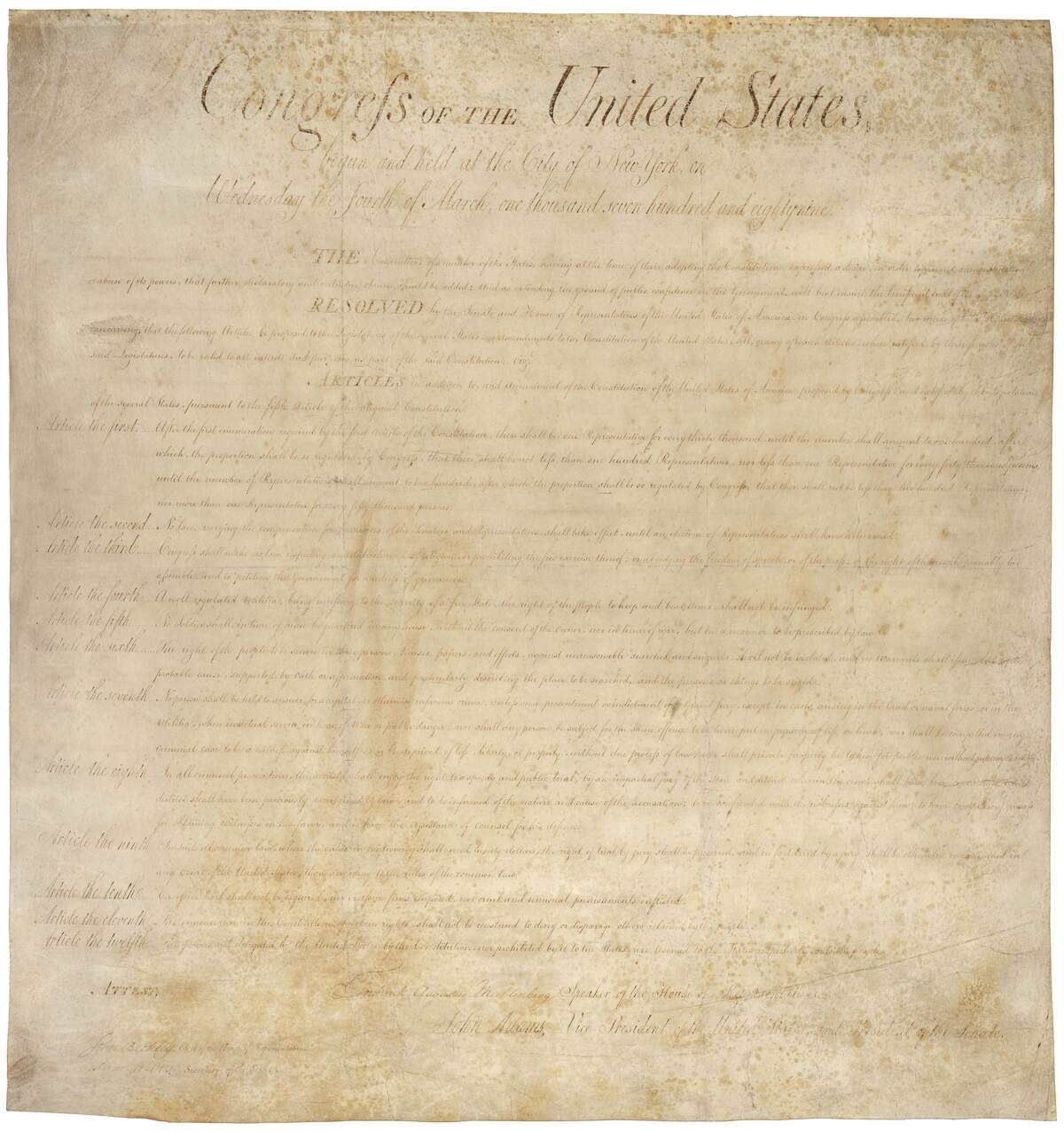

Bill of Rights Day
Observed
annually on December 15th (since 1941)
Dates
Founded by
President Franklin Delano Roosevelt on November 27th, 1941
Hashtags
Sources
https://en.wikipedia.org/wiki/United_States_Bill_of_Rights#Display_and_honoring_of_the_Bill_of_Rights
https://www.amazon.com/dp/1598888587?tag=checkiday08-20
https://www.archives.gov/founding-docs/bill-of-rights
https://www.history.com/topics/united-states-constitution/bill-of-rights
https://www.loc.gov/law/help/statutes-at-large/77th-congress/session-1/c77s1ch397.pdf
https://www.presidency.ucsb.edu/documents/proclamation-2524-bill-rights-day
On December 15, 1791, Virginia ratified the first ten amendments of the Constitution. With this, the amendments reached the requisite number of state ratifications necessary to become part of the Constitution. Known as the Bill of Rights, the first ten amendments outline the rights of citizens vis-à-vis the federal government. They guarantee that citizens have civil rights and liberties such as freedom of speech, press, and religion; they establish rules for due process of law; they confirm that citizens have rights beyond those spelled out in the Constitution; and they affirm that powers not delegated to the federal government are left to the people and states. It is on today's anniversary of the ratification and implementation of the Bill of Rights that we celebrate Bill of Rights Day.
Bill of Rights Day was first officially marked in 1941. A joint resolution, approved by Congress on August 21, 1941, established the day in order "to provide for the proper observance of the one hundred and fiftieth anniversary of the adoption of the first ten amendments to the Constitution, known as the Bill of Rights." It authorized and requested the President to issue a proclamation designating December 15 as Bill of Rights Day, it called on officials of the government to display the flag, and it invited the "people of the United States to observe the day with appropriate ceremonies and prayer."
In accordance, on November 27, 1941, President Franklin D. Roosevelt issued a presidential proclamation designating December 15, 1941, as Bill of Rights Day. He called upon government officials and citizens to display the flag on public buildings and to meet together for prayers and ceremonies that they deemed appropriate.
He said:
It is especially fitting that this anniversary should be remembered and observed by those institutions of a democratic people which owe their very existence to the guarantees of the Bill of Rights: the free schools, the free churches, the labor unions, the religious and educational and civic organizations of all kinds which, without the guarantee of the Bill of Rights, could never have existed; which sicken and disappear whenever, in any country, these rights are curtailed or withdrawn.
The basis for the Bill of Rights goes back to the Magna Carta, which protected British subjects from royal abuses of power. King John of England put his seal to it in 1215. In 1628, in response to actions taken by Charles I, Parliament adopted the Petition of Right. It forbid imprisonment and taxation without Parliament's consent. In 1689, at the end of the Glorious Revolution, when William and Mary ascended to the throne, Parliament adopted their own Bill of Rights, which foreshadowed America's Bill of Rights.
In colonial America, the protection of individual liberties was present in colonial charters, such as in the 1606 Charter for Virginia. These charters declared that those living in the colonies had the same rights as those living in England. Resolutions adopted in America at the time referenced the Magna Carta, colonial charters, and the teachings of natural law. Following the declaration of America's independence in 1776, state constitutions and state bills of rights were written. Virginia's Declaration of Rights, principally written by George Mason, was the model for bills of rights in other states, and then for the federal Bill of Rights. It alluded to John Locke's views on natural rights and provided for protection against specific abuses.
At the Constitutional Convention, held in Philadelphia in 1787, there was a motion to form a committee that would create a bill of rights. But the delegates defeated the motion because they didn't think such a document was necessary because the federal government was to be one with enumerated powers—it only would have those powers which were listed in the Constitution. James Madison first opposed a bill of rights, calling such protections "parchment barriers," thinking they would not be effective. He and some of the other framers questioned how effective a bill of rights would be in protecting the minority against the majority. They instead thought that protections should come from structural arrangements such as the separation of powers and checks and balances.
George Mason was one of three delegates at the Constitutional Convention who refused to sign the Constitution because it did not include a bill of rights. He also wrote a pamphlet opposing the Constitution as written, which many citizens read and were persuaded by. Eventually, Madison and other supporters of the Constitution realized they must placate those opposed to it by adding amendments. Once a pledge to include amendments—what would become the Bill of Rights—was made, a path to ratification came into view. Madison, who had earlier been opposed to a bill of rights, began to push hard for it. During the First Congress, he organized the amendments that were to be included with the Constitution. He considered those that had been proposed by the states during their state ratifying conventions, and focused the amendments on rights, not on structural changes to government, working to find amendments that would be agreeable to Congress and the states. Some in the House of Representatives believed there were other issues that time could be better spent on, and the Antifederalists were hoping for a second Constitutional Convention where the powers of the federal government would be weakened, but Madison persisted.
Madison introduced his amendments on June 8, 1789, and pushed his colleagues for their passage. The House passed a joint resolution that included seventeen of the amendments, and the Senate changed the joint resolution so it only contained twelve of them. In September, the House and Senate accepted a conference report of the amendments, and twelve were adopted. President Washington submitted them to the states for ratification on October 2. Nine states ratified ten of the amendments within six months. On December 15, 1791, Virginia became the eleventh state to ratify ten of the amendments. As there were fourteen states in the Union at the time, the three-fourths threshold needed for ratification had been reached for those ten amendments. They became the Bill of Rights.
When passed, the Bill of Rights was only applicable to the federal government, not the states. It has since been incorporated to largely apply to the states as well. There is still much debate about the interpretation of some portions of the Bill of Rights. But since today's date in 1791, it has been enshrined in the Constitution, ensuring rights and liberties to citizens of the United States.
The Bill of Rights is as follows:
Amendment I
Congress shall make no law respecting an establishment of religion, or prohibiting the free exercise thereof; or abridging the freedom of speech, or of the press; or the right of the people peaceably to assemble, and to petition the government for a redress of grievances.
Amendment II
A well-regulated militia being necessary to the security of a free State, the right of the people to keep and bear arms shall not be infringed.
Amendment III
No soldier shall, in time of peace, be quartered in any house without the consent of the owner, nor in time of war, but in a manner to be prescribed by law.
Amendment IV
The right of the people to be secure in their persons, houses, papers, and effects, against unreasonable searches and seizures, shall not be violated, and no warrants shall issue but upon probable cause, supported by oath or affirmation, and particularly describing the place to be searched, and the persons or things to be seized.
Amendment V
No person shall be held to answer for a capital, or otherwise infamous crime, unless on a presentment or indictment of a grand jury, except in cases arising in the land or naval forces, or in the militia, when in actual service in time of war or public danger; nor shall any person be subject for the same offense to be twice put in jeopardy of life or limb; nor shall be compelled in any criminal case to be a witness against himself, nor be deprived of life, liberty, or property, without due process of law; nor shall private property be taken for public use without just compensation.
Amendment VI
In all criminal prosecutions, the accused shall enjoy the right to a speedy and public trial, by an impartial jury of the State and district wherein the crime shall have been committed, which district shall have been previously ascertained by law, and to be informed of the nature and cause of the accusation; to be confronted with the witnesses against him; to have compulsory process for obtaining witnesses in his favor, and to have the assistance of counsel for his defense.
Amendment VII
In suits at common law, where the value in controversy shall exceed twenty dollars, the right of trial by jury shall be preserved, and no fact tried by a jury shall be otherwise reexamined in any court of the United States, than according to the rules of the common law.
Amendment VIII
Excessive bail shall not be required, nor excessive fines imposed, nor cruel and unusual punishments inflicted.
Amendment IX
The enumeration in the Constitution, of certain rights, shall not be construed to deny or disparage others retained by the people.
Amendment X
The powers not delegated to the United States by the Constitution, nor prohibited by it to the States, are reserved to the States respectively, or to the people.
How to Observe Bill of Rights Day
Here are a few suggestions on how to observe the day:
- Display the American flag at your home, and on public buildings as well, if you are in a position to do so.
- Read the Bill of Rights. (See the holiday's "Description" for the text.) You could even work to memorize it!
- Take a quiz about the Bill of Rights.
- Meet together for prayers and ceremonies that you deem appropriate, as Congress and President Franklin Roosevelt encouraged on the first observance of the day in 1941.
- As Franklin Roosevelt also said in his 1941 proclamation, use the holiday as a "day of mobilization for freedom and for human rights, a day of remembrance of the democratic and peaceful action by which these rights were gained, a day of reassessment of their present meaning and their living worth."
- View the federal government's original copy of the Bill of Rights at the National Archives Museum. A Bill of Rights Day Naturalization Ceremony is held each year at the museum, which you could also attend.
- Check to see if there are any Bill of Rights Day events or naturalization ceremonies in your community that you could attend.
- Explore more resources about the Bill of Rights from the National Archives.
- If you are not an American citizen and wish to be, today is an excellent day to work towards becoming one.
- Read a book about the Bill of Rights.





















